Visit your favourite destinations |
| A Report from birdtours.co.uk |
Region of BRENNE, France, 2000,
(Full versions of the excellent photographs in this report are available here)Objectives of this Trip Report
to share the enjoyment of the countryside's beauty, its fauna
to provide details on the area (maps, hides) with coordinates for GPS users (I used the Magellan GPS 300)
to stimulate birders to use GPS (Global Positioning System units) for more accurate data on spots, observations for future trip reports
to share interesting pictures (all taken by myself with Optolyth 100 / adaptor)
(to deliver a list of bird species seen - though not the primary goal)
We visited the Brenne Natural Parc this Summer from July 30 until August 5th, 2000. The weather was great, with temperatures around 25°C (one day even up to 37°C). We stayed at the Auberge La Gabrière, (36220 Etang de La Gabrière, tel. 00 33 2 54 37 80 97, 46°45'60 N / 001°09'68 E). It can be reached (coming from the north) via Paris (highway A10), Orleans (A71) 47°54'18 N / 001°50'91 E, Vierzon (A20 - E9) 47°14'62 N / 002°03'99 E, to Chateauroux 46°49'59 N / 001°38'33 E. Here you can leave the highway towards Buzançais (46°53'26 N / 001°24'27 E) using the N143, then heading south with the D926 via Ste Gemme, to Mézières-en-Brenne (46°49'30 N / 001°12'45 E).
Mézières-en-Brenne is the historical capital of the Brenne region which is situated in the departement Indre. You can find a map of the region when you click here. The general website of the Brenne parc is www.parc-naturel-brenne.fr (click on the big picture on their startpage). The parc is explained ("le parc en quelques mots") and it is containing wonderful landscape pictures taken by JF Hellio and N Van Ingen (HVI). The parc has also its mission statement and a charter.
The Region of Brenne, also called "la Région des 1000 étangs / the region of the 1000 ponds" is little known by tourists but very liked by birds (and ornithologists) because of the quietness of the landscape, the multitude of biotopes (hedgerows, moorland, woods, fields) and the presence of so many ponds / lakes. The reserve has several hide facilities, such as La Chérine (there is a guide present in the morning from 10 to 12 except on Fridays), at Etang Massé in front of Le Blizon, and at the new place called Le Foucault (three hides) at 46°43'61N / 001°14'12E. All these places have a car parking. For a plan "where to go" (including the position of the hides, the ponds, etc.) click here. There are almost everywhere well indicated paths for hiking (randonnées).
There is also a Parc Visitor Center, called la Maison du Parc which you can visit every day at the castle of Bouchet (tel +33 2 54 28 12 13). Their website is : www.parc-naturel-brenne.fr/brennesite/parc/pages/maisonparc.html .
At our hotel, there were several ornithologists from Belgium (TD and FDE) and we herewith also send our best wishes to Mr and Mrs MGS from Paris.
TYPICAL LANDSCAPES
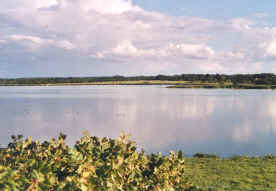 La Gabrière (seen from the Auberge) |
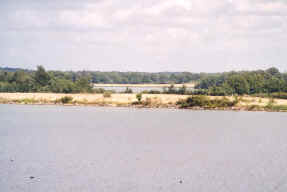 Le Foucault reserve (seen from the hide) |
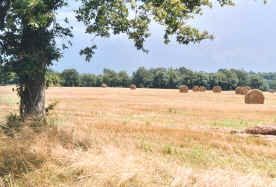 typical landscape in early August |
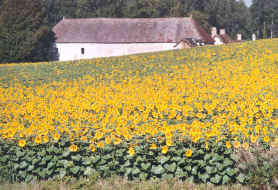 sunflowers everywhere |
BIRD LIST with PICTURES and for some important spots the coordinates (in red)
1. Great Crested Grebe
/ Fuut (Podiceps cristatus) : observed on almost all ponds
2. Little Grebe / Dodaars (Tachybaptus ruficollis) :
not so frequent
3. Black-necked Grebe / Geoorde fuut (Podiceps
nigricollis) : mainly at La Gabrière, still with juveniles
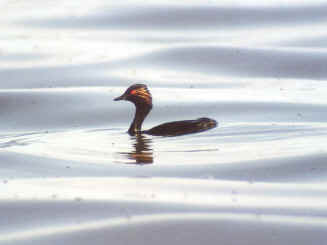
Black-necked Grebe at la Gabrière
4. Great Cormorant
/ Aalscholver (Phalacrocorax carbo) : was seen almost everywhere
but mainly on La Gabrière, Le Foucault, 20+ at le Blizon (46°44'45 / 001°13'46),
la Chérine. At le Foucault, we saw one with three colored rings
on the left leg (from bottom to top : Orange - Red - White), while there was
a metal ring on the right leg
5. Great Bittern / Roerdomp (Botaurus stellaris)
: seen by French people
6. Night Heron / Kwak (Nycticorax Nycticorax)
: an adult at le Temple each evening from 18:00 on until next day around 10:00,
a juvenile at le Blizon, and at least 5 juveniles at la Chérine (see pictures
below)
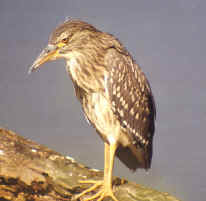 Juvenile Night Heron |
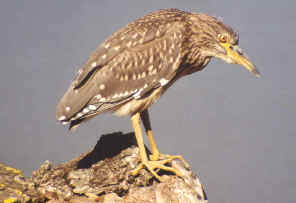 Juvenile Night Heron (nest of 5 or 6) |
7. Cattle Egret / Koereiger (Bubulcus
ibis) : regular visitors almost everywhere : 30+ at le Blizon; one evening,
there were 150+ near the road from La Gabrière to Mézières !
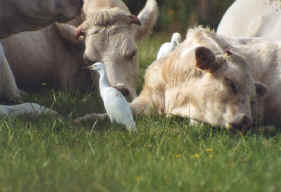 Cattle Egret ... with the local cattle |
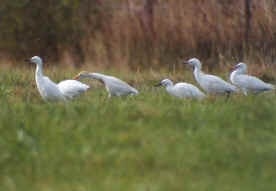 see mature Cattle Egret (3rd from left) |
8. Little Egret / Kleine zilverreiger (Egretta
garzetta) : mainly at la Chérine and le Blizon
9. Grey Heron / Blauwe reiger (Ardea
cinerea) : very frequent, sometimes up to 9 birds at e.g. new pond near
Mézières along the road D21 at la Roche Marteau, or up to 10 around le Blizon
10. Purple Heron / Puperreiger (Ardea purpurea) : regularly
seen; always at new pond near Mézières along the road D21 at la Roche Marteau
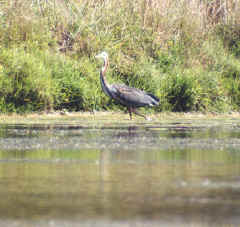 Purple Heron (adult) |
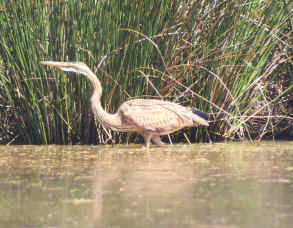 Purple Heron (juvenile) |
11. Great White Heron / Grote zilverreiger (Egretta
alba) : at le Foucault
12. Mute Swan / Knobbelzwaan (Cygnus olor) :
at several ponds, but most at La Gabrière with almost 25 birds
13. Mallard / Wilde eend (Anas platyrhynchos)
: abundant, everywhere
14. Common Pochard / Tafeleend (Aythya ferina) : le Blizon,
le Foucault
15. Tufted Duck / Kuifeend (Aythya fuligula)
: mainly at le Foucault
16. Black Kite / Zwarte wouw (Milvus migrans)
: seen frequently, a.o. at le Foucault (2)
17. Red Kite / Rode wouw (Milvus milvus) : 2
overflying at le Blizon
18. Marsh Harrier / Bruine kiekendief (Circus aeruginosus)
: especially at la Chérine (2)
19. Eurasian Sparrowhawk / Sperwer (Accipiter nisus) :
alongside a small wood
20. Common Buzzard / Buizerd (Buteo buteo) : very frequent
: many are sitting on the round hay packs.
21. Common Kestrel / Torenvalk (Falco tinnunculus) : frequent
but less than Buzzard
22. Common Pheasant / Fazant (Phasianus colchicus) : now
and then
23. Moorhen / Waterhoen (Gallinula chloropus) : not so
frequent
24. Common Coot /Meerkoet (Fulica atra) : very
frequent, hundreds at la Gabrière, le Blizon
25. Northern Lapwing / Kievit (Vanellus vanellus) : about
20 at the new pond near Mézières along the road D21 at la Roche Marteau
26. Common Sandpiper / Oeverloper (Actitis
hypoleucos) : several at le Foucault and at la Gabrière, one at Neons
27. Black-Winged Stilt / Steltkluut (Himantopus himanthopus) :
three at the new pond near Mézières along the road D21 at la Roche Marteau (
46°48'64 / 001°12'64 )
28. Black-headed Gull / Kokmeeuw (Larus ridibundus) : many
along the road D21 at la Roche Marteau
29. Common Tern / Visdiefje (Sterna hirundo)
: seen mainly at la Gabrière together with 29.
30. Whiskered Tern / Witwangstern (Chlidonias hybridus)
: about 10+ at le Blizon, many at la Gabrière, at la Chérine, on the pond just
opposite of le Foucault and at the pond of Montiacre
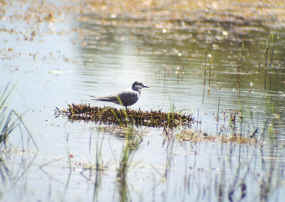 Whiskered Tern at Montiacre |
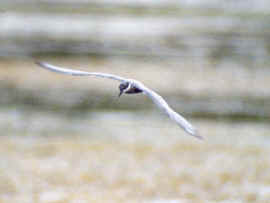 Whiskered Tern |
31. Black Tern / Zwarte stern (Chlidonias
niger) : only 2 at la Gabrière
32. Wood Pigeon / Houtduif (Columba palumbus) : almost
everywhere
33. Eurasian Collared Dove / Tortelduif (Streptopelia
decaocto) : very common
34. Turtle Dove / Zomertortel (Streptopelia turtur) : at
Neons (see Bea-eaters below)
35. Common Kingfisher / IJsvogel (Alcedo atthis) : two
at la Chérine, one at étang du Sault ,
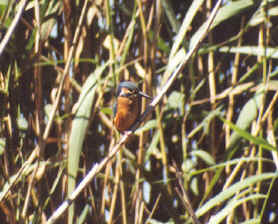
Kingfisher at Le Foucault
36. European Bee-eater / Bijeneter (Merops
apiaster) : an important colony can be found near La Roche Posay
(15+ birds) at 46°47'31 N / 000°49'00 E : the best way to see the first colony
is to go through the small arch when entering La Roche, then turn immediately
left direction Vicq, about 500m further (animal food production unit),
to the left (road descends) straight ahead towards the river at 46°47'02 N /
000°49'70 E. (according to a fisherman, these birds are here since about
6 years). The second colony is at Neons sur Creuse (46°45'06 /
000°55'97) (descend behind the church to the river : at the picnic place, continue
on the small road that starts at car parking) (46°45'28 / 000°55'55)
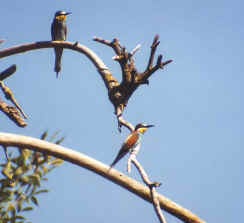 European Bee-eater at La Roche |
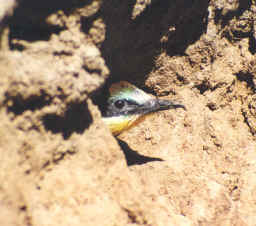 juvenile European Bee-eater |
37. Hoopoe / Hop (Upupa epops) :
one near la Gabrière and one at Maupas and at 46°43'83 / 001°12'51.
38. Green Woodpecker / Groene specht (Picus viridis) :
regular bird
39. Great Spotted Woodpecker / Grote bonte specht (Dendrocopos
major) : regular
40. Sky Lark / Leeuwerik (Alauda arvensis) : regular in
fields
41. Sand Martin / Oeverzwaluw (Riparia riparia)
: regular
42. Barn Swallow / Boerenzwaluw (Hirundo rustica)
: very frequent
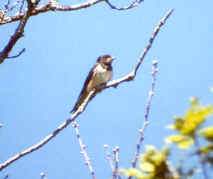 Barn Swallow |
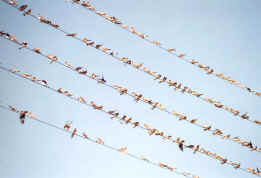 grouping at Rosnay |
43. House Martin / Huiszwaluw (Delichon
urbica) : quite frequent : at Rosnay, there was a group of almost 1000 birds
on the electricity wires (see picture)
44. Yellow Wagtail / Gele kwikstaart (Motacilla flava)
: a couple of birds at a pond
45. Grey Wagtail / Grote gele kwikstaart (Motacilla cinerea)
: a couple seen at étang du Sault (46°43'87 / 001°14'38)
46. Pied Wagtail / Witte kwikstaart (Motacilla alba) :
here and there
47. Wren / Winterkoning (Troglodytes troglodytes) : quite
frequent
48. Hedge Accentor / Heggemus (Prunella modularis) : songs
heard
49. European Robin / Roodborst (Erithacus rubecula) : frequent
50. Black Redstart / Zwarte roodstaart (Phoenicurus
ochrurus) : around farms
51. Common Stonechat / Roodborsttapuit (Saxicola
torquata) : quite frequent / almost everywhere
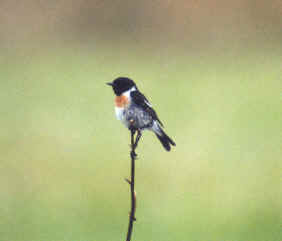 Common Stonechat |
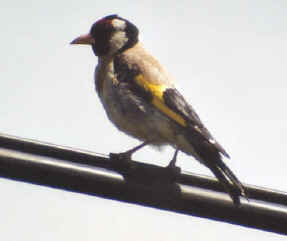 Goldfinch |
52. Blackbird / Merel
(Turdus merula) : frequent
53. Reed Warbler / Kleine Karekiet (Acrocephalus
scirpaceus) : at la Gabrière etc.
54. Blackcap / Zwartkop (Sylvia atricapilla)
: frequent
55. Common Chiffchaff / Tjiftjaf (Phylloscopus
collybita) : frequent
56. Spotted Flycatcher / Grauwe vliegenvanger
(Muscicapa striata) : seen at La Gabrière
57. Long-tailed Tit / Staartmees (Aegithalos
caudatus) : frequent
58. Blue Tit / Pimpelmees (Parus caeruleus)
: frequent
59. Great Tit / Koolmees (Parus major)
: frequent
60. Red-backed Shrike / Grauwe klauwier (Lanius
collurio) : very frequent
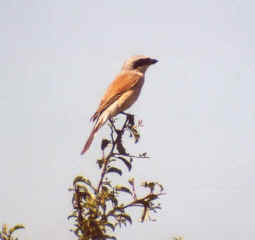 Red-backed Shrike ( m ) |
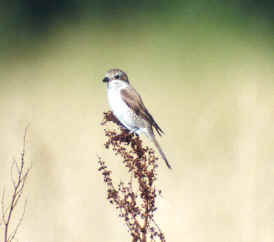 Red-backed Shrike ( juv ) |
61. Eurasian Jay / Gaai
(Garrulus glandarius) : frequent
62. Black-billed Magpie / Ekster (Pica
pica) : frequent
63. Eurasian Jackdaw / Kauw (Corvus monedula)
: frequent
64. Carrion Crow / Kraai (Corvus corone)
: frequent
65. Common Starling / Spreeuw (Sturnus
vulgaris) : frequent
66. House Sparrow / Huismus (Passer domesticus)
: frequent
67. Chaffinch / Vink (Fringilla coelebs)
: frequent
68. Greenfinch / Groenling (Carduelis
chloris) : frequent
69. Goldfinch / Putter (Carduelis carduelis)
: frequent
70. Linnet / Kneu (Carduelis cannabina)
: frequent
Additional Comments
1. Little Bustard / Kleine trap (Tetrax tetrax) : one has been seen until recently (up to the moment that the fields were ploughed) near Haute Couture, at 46°50'66 / 001°05'77 (north of Mézières).
2. A Woodchat Shrike / Roodkopklauwier (Lanius senator) was seen until recently around the second hide at Le Foucault
3. A Great Grey Shrike / Klapekster (Lanius excubitor) could be seen between le Temple and le Maupas (direction to Le Blizon)
Ivan Steenkiste (Ivan's Web Site)
Why not send us a report, or an update to one of your current reports?